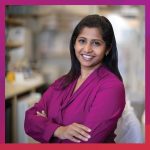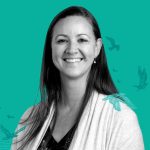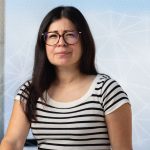Insights Trinka Adamson Supporting Salk science through animal care
On the shores of a lake in Arkansas, baby Trinka Adamson got a kiss on the cheek from a deer.
“My mom likes to recount that memory and say she knew from that moment that I’d work with animals one day—but I think the deer was probably just licking off some leftover food from my face,” laughs Adamson.
Adamson, now senior director of Salk’s Animal Resources Department, takes immeasurable pride in her work at the Institute. Through college years of physiology courses, triathlon training, and a career detour into human medicine, Adamson kept finding her way back to animals. As a child, she wanted to be a veterinarian. When she got to college, her personal love for exercise physiology inspired a medical school track. But after shadowing in hospitals, she turned back to animal sciences and went on to veterinary school, where she discovered that a board specialty in laboratory animal medicine existed. She then knew she was meant to follow that path and be involved with animal research. Her greatest joy comes not only from caring for animals, but also from supporting the faculty and innovative science possible only at Salk.
Early Life
Born and raised in Shreveport, Louisiana, Adamson dreamed of being a veterinarian from her earliest years. But at just 10 years old, she got a chance to sit in on a veterinary surgery and concluded she was too emotional to deal with animals in a clinical setting. So, given her self-identified sensitivity with animals and an extracurricular interest in sports, she pivoted to human physiology.
Adamson attended the University of Arizona, where she began volunteering in hospitals and joined an undergraduate teaching team that inspired a love for teaching that endures today. She narrowed her focus to exercise physiology and began a graduate program in physiology, but when she got there, her passion for animal science was rekindled.
“I was the annoying grad student,” says Adamson. “I would question whether we were using the best animal model for the work, whether we should be using more modern anesthetic protocols, or if we should provide more animal enrichment. It was obvious in those years that animal science was my passion.”
She realized that caring about the animals meant caring for the animals, and that her sensitivity ultimately was a strength. Her emotional vulnerability manifested as extreme diligence in her studies and premium quality of animal care as she transitioned into veterinary school after graduate school.
Joining Salk
After her veterinary laboratory animal medicine residency at UC Davis, she worked at the City of Hope Beckman Research Institute in Duarte, California, as a clinical veterinarian and then associate director. After 10 years of employment at City of Hope, Adamson joined Salk as the attending veterinarian for the institution and the senior director of the Animal Resources Department. As the senior director, Adamson is responsible for overseeing the management of department staff and operations and coordinating the care of a variety of rodents, small mammals, and nonhuman primates.
“No two days are alike at Salk,” says Adamson. “There are emails, protocols, papers, at times grants to read or write, faculty questions to answer, teaching and training to complete, and a whole lot of problems to solve. It’s like Tetris every day—shifting things around so everyone and everything is aligned to best support the science.”
Adamson and the Animal Resources Department team provide the highest-quality veterinary medical care, husbandry, enrichment, and professional technical support to enable the scientists to perform their animal research. Importantly, as Adamson mentioned, they accommodate the rapidly changing needs of the scientists, while maintaining a foundation of high-quality animal care and use.
Adamson boasts not only about the quality of the Animal Resources Department output at Salk, but also of the community that surrounds her. Her colleagues in her department and the faculty that rely on their work offer encouragement to start that game of Tetris fresh every day.
“I am very proud to support the animal research here at Salk,” says Adamson. “Everyone is here for the right reasons, so I wake up every day feeling excited about what I do. And best of all, the research at Salk is just so above and beyond any other research I have ever supported in my career.”
Off-Campus Adventures
When she’s off campus, Adamson enjoys traveling with her family and showing her two daughters the world. They travel within the country, like to Washington State or back home to Louisiana, and go on longer trips abroad, like a past trip to Germany and an upcoming vacation to Costa Rica.
“You learn so much from others when you travel,” says Adamson. “I want to instill in my daughters that there are numerous cultures out there and many ways to live. There’s just so much to see in the world, and the more you see, the more you get a sense for who you are and who you want to be.”
Fun Fact
These days, Adamson is too busy to continue with her old triathlon hobby. Instead, she puts her energy into supporting her daughters’ schools and interests, while finding some time on the side for book clubs, hiking, Pilates, musical theater, and exploring San Diego.
What Lies Ahead
Salk plans to break ground next year on the new, 100,000-square-foot Joan and Irwin Jacobs Science and Technology Center. The expansion of the campus creates the opportunity for the Animal Resources Department to grow as well. New buildings bring the promise of new animal facilities and potentially new animals, which encourages Adamson to set high expectations for the impact of her efforts. She hopes, too, that her work ethic and adventurous philosophy inspire her girls as they grow up.
Support a legacy where cures begin.
Featured Stories
 Deepshika Ramanan–From iguana poop to breastmilkRamanan, a new assistant professor and microbiologist by training, made a chance discovery about animal gut bacteria that led to her fascination with breastmilk immunity.
Deepshika Ramanan–From iguana poop to breastmilkRamanan, a new assistant professor and microbiologist by training, made a chance discovery about animal gut bacteria that led to her fascination with breastmilk immunity. New strategic plan provides roadmap for enhancing diversity, equity, inclusion, and belonging at SalkGroundbreaking scientific discoveries require talented people behind the scenes, and the more diverse those people are, the more groundbreaking their discoveries. At Salk, improving diversity, equity, and inclusion is a commitment to both scientific discovery and humanity.
New strategic plan provides roadmap for enhancing diversity, equity, inclusion, and belonging at SalkGroundbreaking scientific discoveries require talented people behind the scenes, and the more diverse those people are, the more groundbreaking their discoveries. At Salk, improving diversity, equity, and inclusion is a commitment to both scientific discovery and humanity. Trinka Adamson–Supporting Salk science through animal careAdamson, senior director of Salk’s Animal Resources Department, works to provide the highest quality veterinary medical care, husbandry, enrichment, and professional technical support to enable our scientists to conduct their animal research and make their bold discoveries.
Trinka Adamson–Supporting Salk science through animal careAdamson, senior director of Salk’s Animal Resources Department, works to provide the highest quality veterinary medical care, husbandry, enrichment, and professional technical support to enable our scientists to conduct their animal research and make their bold discoveries. Melissa Hernandez–Horses, hot sauce, and human brain researchHernandez, a postdoctoral researcher in the lab of Professor Rusty Gage, journeyed up and down the west coast and turned from scientist to hot sauce entrepreneur and back before finally settling at Salk to study neuroscience.
Melissa Hernandez–Horses, hot sauce, and human brain researchHernandez, a postdoctoral researcher in the lab of Professor Rusty Gage, journeyed up and down the west coast and turned from scientist to hot sauce entrepreneur and back before finally settling at Salk to study neuroscience. To inspire and educate: Salk’s Education Outreach is on a missionMotivated by Jonas Salk’s admonition to “be good ancestors,” Education Outreach strives to inspire the next generation of scientists. By running programs like the Mobile Science Lab or High School Science Day among others, Education Outreach encourages scientific literacy, enthusiasm in science as a career, and awareness of the value of basic research.
To inspire and educate: Salk’s Education Outreach is on a missionMotivated by Jonas Salk’s admonition to “be good ancestors,” Education Outreach strives to inspire the next generation of scientists. By running programs like the Mobile Science Lab or High School Science Day among others, Education Outreach encourages scientific literacy, enthusiasm in science as a career, and awareness of the value of basic research.




















































